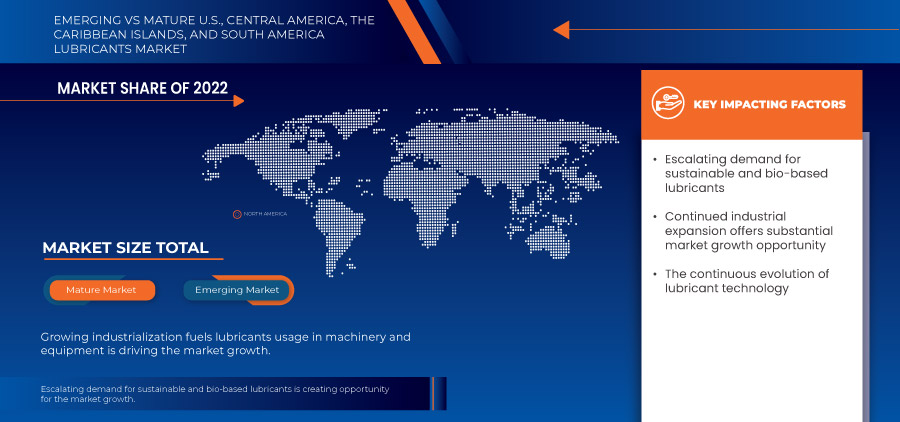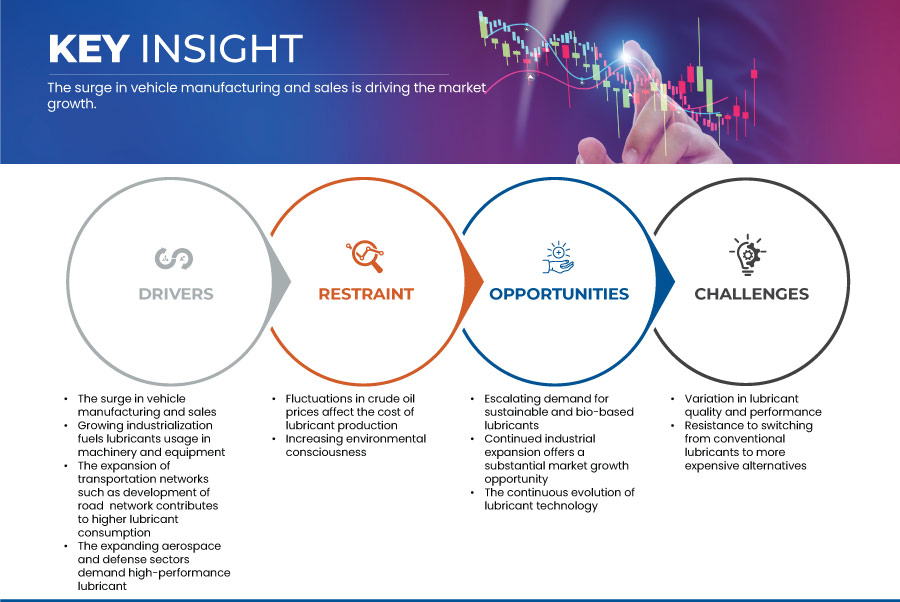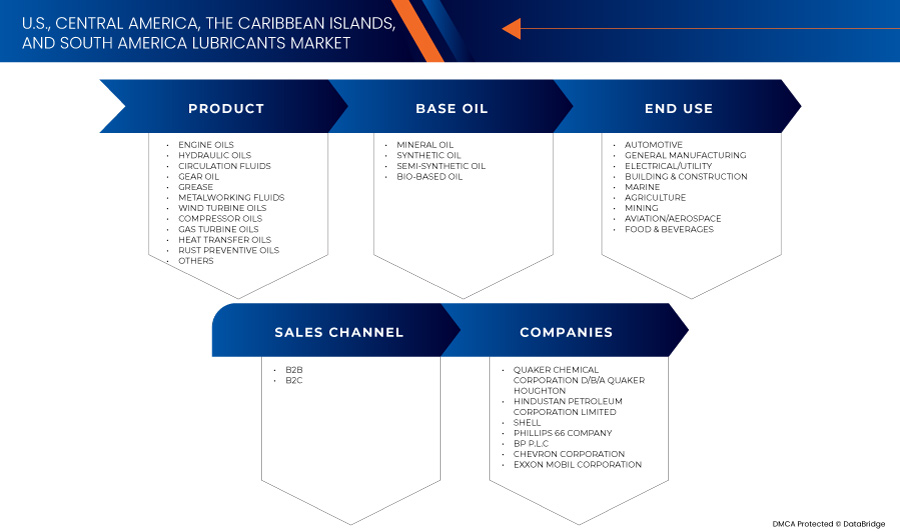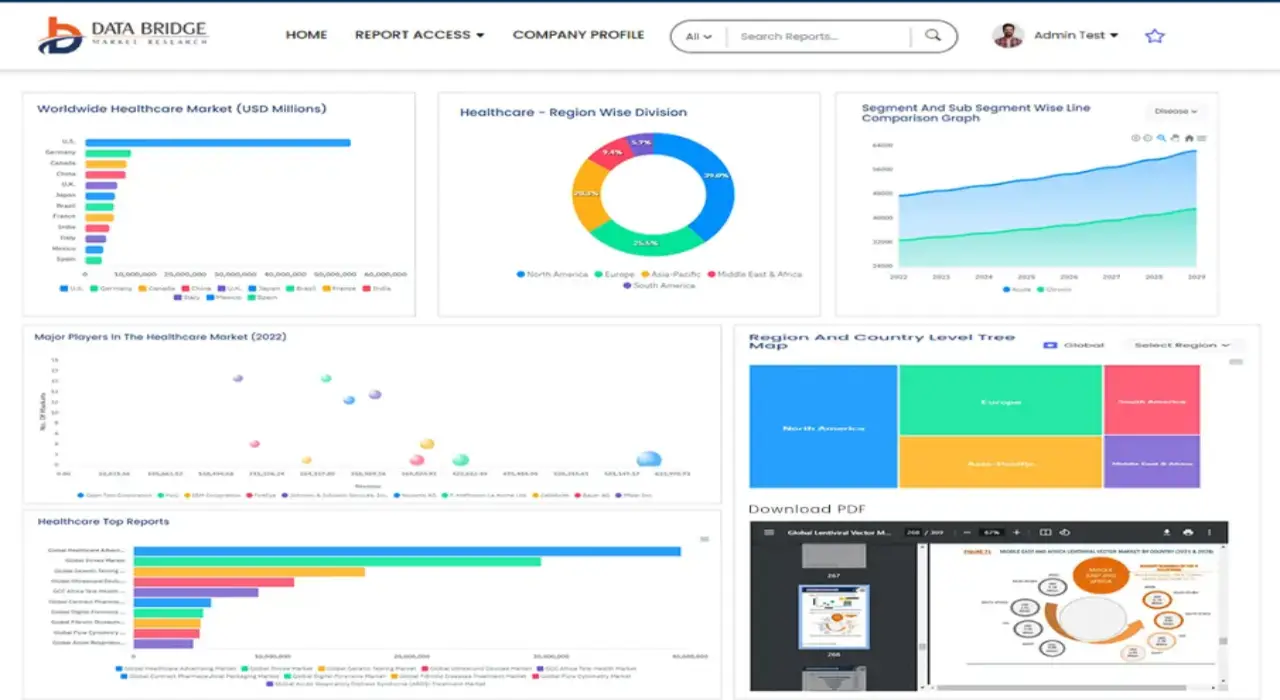U S Central America The Caribbean Islands And South America Lubricants Market
Marktgröße in Milliarden USD
CAGR :
% 
 USD
32.73 Billion
USD
58.38 Billion
2024
2032
USD
32.73 Billion
USD
58.38 Billion
2024
2032
| 2025 –2032 | |
| USD 32.73 Billion | |
| USD 58.38 Billion | |
|
|
|
U.S., Central America, the Caribbean Islands, and South America Lubricants Market Segmentation, By Product (Engine Oils, Hydraulic Oils, Circulation Fluids, Gear Oil, Grease, Metalworking Fluids, Wind Turbine Oils, Compressor Oils, Gas Turbine Oils, Heat Transfer Oils, Rust Preventive Oils, and Others), Base Oil (Mineral Oil, Synthetic Oil, Semi-Synthetic Oil, and Bio-Based Oil), Sales Channel (B2B and B2C), End-Use (Automotive, General Manufacturing, Electrical/Utility, Building & Construction, Marine, AgricultureMining, Aviation/Aerospace, and Food & Beverages) - Industry Trends and Forecast to 2031
Lubricants Market Analysis
The market is driven by vehicle manufacturing and sales are the key factors fuelling the market expansion. Escalating demand for sustainable and bio-based lubricants opportunities for market growth. However, Fluctuations in crude oil prices affect the cost of lubricant production as a notable restraint affecting the market. Furthermore, the highly competitive lubricant industry manufacturers require constant innovation and differentiation challenge market growth. The continuous evolution of lubricant technology is a rising opportunity that has the potential to lead to market growth. Resistance to switching from conventional lubricants to more expensive alternatives have emerged as significant challenges impacting the growth trajectory of the market.
Lubricants Market Size
Data Bridge Market Research analyses that the U.S., Central America, the Caribbean Islands, and South America lubricants market is expected to reach a value of USD 53.79 billion by 2031 from 30.45 billion in 2023, growing at a CAGR of 7.5% during the forecast period 2024 to 2031. In addition to the market insights such as market value, growth rate, market segments, geographical coverage, market players, and market scenario, the market report curated by the Data Bridge Market Research team includes in-depth expert analysis, import/export analysis, pricing analysis, production consumption analysis, and PESTLE analysis
Lubricants Market Trends
“Growing Demand in Automotive and Aerospace”
The automotive and aerospace industries are increasingly utilizing adhesive lubricants to enhance performance and durability in critical components, reducing friction and wear. As vehicles and aircraft advance, these lubricants help improve longevity and reliability, especially in high-stress environments. The shift toward electric and hybrid vehicles necessitates specialized solutions that withstand extreme conditions. Additionally, stricter regulatory standards drive demand for high-performance lubricants that ensure compliance. This combination of factors solidifies the role of adhesive lubricants in future engineering innovations.
Report Scope and Lubricants Market segmentation
|
Report Metric |
Lubricants Market Insights |
|
Segments Covered |
|
|
Countries Covered |
Jamaica, Cuba, Dominican Republic, Haiti, Trinidad & Tobago, Rest of The Caribbean Islands, Guatemala, Costa Rica, Panama, El Salvador, rest of Central America, U.S., Brazil, Argentina, Venezuela, Peru, Chile, and Rest of South America |
|
Key Market Players |
Quaker Chemical Corporation d/b/a Quaker Houghton (U.S.), Hindustan Petroleum Corporation Limited (India), Shell (U.K.), Chevron Corporation (U.S.), Exxon Mobil Corporation (U.S.), BP p.l.c. (U.K.), CARL BECHEN GMBH (Germany), Motul (France), Phillips 66 Company (U.S.), TotalEnergies (France), and Valvoline (U.S.) among others |
|
Market Opportunities |
|
|
Value Added Data |
In addition to the market insights such as market value, growth rate, market segments, geographical coverage, market players, and market scenario, the market report curated by the Data Bridge Market Research team includes in-depth expert analysis, import/export analysis, pricing analysis, production consumption analysis, and PESTLE analysis. |
Lubricants Market Definition
Lubricants are organic compounds employed to minimize friction and heat generation between interacting surfaces. They may also possess properties for conveying forces, particles, or regulating temperature, with the expectation of maintaining their effectiveness at elevated temperatures.
Lubricants Market Dynamics
This section deals with understanding the market drivers, advantages, opportunities, restraints, and challenges. All of this is discussed in detail below:
Drivers
- The Surge in Vehicle Manufacturing and Sales
The market is driven by a variety of factors, including the spike in vehicle production and sales around the world. This growing trend is supported by rising vehicle ownership, technical development, rising maintenance costs, increased global trade, and its knock-on impacts on economic expansion. The lubricants market will be essential in guaranteeing the best performance and sustainability of cars around the world as the automotive industry develops further. Thus, a worldwide surge in vehicle manufacturing and sales is expected to drive market growth.
For instance,
According to GoodCarBadCar, SUV market share in South America saw significant growth, rising from 35% in 2019 to 45% in 2022. This trend indicated positive momentum in the passenger car market, with expectations of continued growth in the coming years. This increase in sales of SUVs influence the demand of lubricants in the region.
- Growing Industrialization Fuels Lubricant Usage in Machinery and Equipment
Growing industrialization is a dynamic and multifaceted driver for the market. It encompasses various industries, sectors, and applications, all of which rely on lubricants for smooth, efficient, and environmentally responsible operations. The lubricants market will remain an essential component of industrial growth and sustainability, ensuring the seamless operation of machinery and equipment across diverse sectors, as industrialization continues to advance. Thus, growing industrialization fuels lubricant usage in machinery and equipment and is expected to drive market growth.
For instance,
- In April 2024, reported by Forst & Sullivan that in March, Stellantis announced a historic EUR 5.6 billion (USD 6081.60 million) investment in Latin America's automotive industry, focusing on electric and hybrid vehicles. This five-year plan, starting in 2025, aims to launch nearly 40 new models and highlights the region's growth potential, with a projected 4.8% YoY increase in 2024. This automotive industry development increases the consumption of specialised lubricants.
Opportunities
- Escalating Demand for Sustainable and Bio-Based Lubricants
The escalating demand for sustainable and bio-based lubricants presents a significant opportunity for the market. Industries and consumers are actively seeking lubricant solutions that are not only effective but also environmentally friendly, as environmental concerns continue to gain momentum. This shift in demand has opened up several avenues for growth and innovation within the lubricants industry. One of the key opportunities lies in the development and production of bio-based lubricants. These lubricants are derived from renewable resources such as plant oils, animal fats, and even microbial sources. Unlike traditional mineral oil-based lubricants, bio-based lubricants have the advantage of being biodegradable and less harmful to the environment. They also offer improved biodegradability and reduced toxicity, making them a preferred choice in applications where environmental impact is a concern.
For instance,
- In the article by STLE org, Biobased lubricants, such as soy-based hydraulic fluid and vegetable oil-derived additives, show promise in various applications, from elevators to farm equipment. They offer advantages such as biodegradability, lower toxicity, and enhanced lubricity, though challenges such as poor oxidation stability and high pour points persist. Innovations aim to overcome these limitations, making biobased lubricants competitive with synthetic counterparts. Recycling remains a challenge, with mixed opinions on its feasibility.
Continued Industrial Expansion Offers a Substantial Market Growth Opportunity
Continued industrial expansion presents a substantial growth opportunity for the market. As economies evolve and industrialization remains a driving force, the demand for lubricants across various sectors is expected to surge. This opportunity arises from the indispensable role lubricants play in maintaining the efficiency, performance, and longevity of industrial machinery and equipment. The rapid urbanization and infrastructure development witnessed in emerging economies. The need for heavy machinery and equipment increases significantly, as these countries invest in building and upgrading infrastructure, such as roads, bridges, airports, and manufacturing facilities. Lubricants are critical for ensuring the smooth operation of these machines, reducing friction, and preventing wear and tear. Moreover, the expansion of construction and infrastructure projects often requires specialized lubricants designed to withstand extreme conditions, further driving demand.
For instance,
- In June 2024, according to the article published by OILPRICE, the Caribbean has seen a surge in renewable energy investments, including solar, geothermal, and battery storage. Projects aim to reduce fossil fuel dependency, boost energy security, and cut costs. Dominica explores geothermal, while Antigua and Barbuda focuses on hurricane-resistant solar. Major projects are underway, including a 128MW solar and 63.2MWh battery auction in the U.S. Virgin Islands by Accion Group and VIElectron.
Restraints/Challenges
- Increasing Environmental Consciousness
Increasing environmental consciousness presents a significant restraint for the market. Industries and consumers similarly are becoming more conscientious about the environmental impact of their choices, as awareness of environmental issues and sustainability grows worldwide. This shift in mindset has several implications for the lubricants industry. The demand for lubricants that are cleaner and more environmentally friendly is one of the main issues. Traditional lubricants frequently contain additives and chemicals that, when released into the environment, can harm ecosystems, especially those that are based on mineral oil. People are increasingly choosing biodegradable and environmentally friendly lubricants that pose fewer threats to soil, water, and wildlife.
For instance,
- In June 2024, according to National Ocean Service, Oil spills from large ships severely impacted marine life, harming birds, mammals, and fish. The spills compromised the insulation of fur-bearing mammals like sea otters and the water repellency of birds' feathers, leading to hypothermia. Juvenile sea turtles became trapped and confused oil for food, while dolphins and whales faced respiratory issues. Many animals ingested oil while cleaning themselves, causing poisoning. Such negative impact on marine environment create awareness among public regarding use of lubricants.
Variation in Lubricant Quality and Performance
Lubricants play a crucial role in the efficient operation of machinery and engines across various industries. Their primary function is to reduce friction, wear, and heat, ensuring smoother and more reliable performance of mechanical systems. High-quality lubricants not only enhance the lifespan of equipment but also contribute to overall operational efficiency and safety. Therefore, maintaining consistent lubricant quality is essential for preventing breakdowns, optimizing performance, and meeting regulatory standards.
For instance,
- In May 2024, Mansfield Energy Corp. highlighted a significant challenge in the lubricant market. The proliferation of products led to varying quality levels, complicating quick lube shops’ efforts to source consistent, high-quality lubricants. This inconsistency caused engine buildup, reduced efficiency, and costly repairs, ultimately risking customer dissatisfaction and damaging shop reputations.
Dieser Marktbericht enthält Einzelheiten zu neuen Entwicklungen, Handelsvorschriften, Import-Export-Analysen, Produktionsanalysen, Wertschöpfungskettenoptimierungen, Marktanteilen, Auswirkungen inländischer und lokaler Marktteilnehmer, analysiert Chancen in Bezug auf neue Einnahmequellen, Änderungen der Marktvorschriften, strategische Marktwachstumsanalysen, Marktgröße, Kategoriemarktwachstum, Anwendungsnischen und -dominanz, Produktzulassungen, Produkteinführungen, geografische Expansionen und technologische Innovationen auf dem Markt. Um weitere Informationen zum Markt zu erhalten, wenden Sie sich an Data Bridge Market Research, um einen Analystenbericht zu erhalten. Unser Team hilft Ihnen dabei, eine fundierte Marktentscheidung zu treffen, um Marktwachstum zu erzielen.
Marktumfang für Schmierstoffe
Der Schmierstoffmarkt in den USA, Mittelamerika, der Karibik und Südamerika ist in vier wichtige Segmente unterteilt, basierend auf Produkt, Grundöl, Vertriebskanal und Endverbrauch. Das Wachstum dieser Segmente hilft Ihnen bei der Analyse schwacher Wachstumssegmente in den Branchen und bietet den Benutzern einen wertvollen Marktüberblick und Markteinblicke, die ihnen dabei helfen, strategische Entscheidungen zur Identifizierung der wichtigsten Marktanwendungen zu treffen.
Produkt
- Motoröle
- Motoröle, nach Grundöl
- Mineralöl
- Mineralöl, nach Typ
- Paraffinische Öle
- Naphtenhaltige Öle
- Aromatische Öle
- Mineralöl, nach Typ
- Synthetisches Öl
- Synthetisches Öl, nach Typ
- Synthetisches Mischöl
- Vollsynthetisches Öl
- Synthetisches Öl, nach Typ
- Teilsynthetisches Öl
- Biobasiertes Öl
- Mineralöl
- Motoröle, nach Grundöl
- Hydrauliköle
- Hydrauliköle, nach Grundöl
- Mineralöl
- Mineralöl, nach Typ
- Paraffinische Öle
- Naphtenhaltige Öle
- Aromatische Öle
- Mineralöl, nach Typ
- Synthetisches Öl
- Synthetisches Öl, nach Typ
- Synthetisches Mischöl
- Vollsynthetisches Öl
- Synthetisches Öl, nach Typ
- Teilsynthetisches Öl
- Biobasiertes Öl
- Mineralöl
- Hydrauliköle, nach Grundöl
- Zirkulationsflüssigkeiten
- Umlaufflüssigkeiten nach Grundöl
- Mineralöl
- Mineralöl, nach Typ
- Paraffinische Öle
- Naphtenhaltige Öle
- Aromatische Öle
- Mineralöl, nach Typ
- Synthetisches Öl
- Synthetisches Öl, nach Typ
- Synthetisches Mischöl
- Vollsynthetisches Öl
- Synthetisches Öl, nach Typ
- Teilsynthetisches Öl
- Biobasiertes Öl
- Mineralöl
- Umlaufflüssigkeiten nach Grundöl
- Getriebeöl
- Getriebeöl, nach Grundöl
- Mineralöl
- Mineralöl, nach Typ
- Paraffinische Öle
- Naphtenhaltige Öle
- Aromatische Öle
- Mineralöl, nach Typ
- Synthetisches Öl
- Synthetisches Öl, nach Typ
- Synthetisches Mischöl
- Vollsynthetisches Öl
- Synthetisches Öl, nach Typ
- Teilsynthetisches Öl
- Biobasiertes Öl
- Mineralöl
- Getriebeöl, nach Grundöl
- Fett
- Fett, nach Typ
- Auf Lithiumbasis
- Auf Kalziumbasis
- Bentone-basiert
- Bariumkomplex
- Sonstiges
- Fett, nach Grundöl
- Mineralöl
- Mineralöl, nach Typ
- Paraffinische Öle
- Naphtenhaltige Öle
- Aromatische Öle
- Mineralöl, nach Typ
- Synthetisches Öl
- Synthetisches Öl, nach Typ
- Synthetisches Mischöl
- Vollsynthetisches Öl
- Synthetisches Öl, nach Typ
- Teilsynthetisches Öl
- Biobasiertes Öl
- Mineralöl
- Fett, nach Typ
- Metallbearbeitungsflüssigkeiten
- Metallbearbeitungsflüssigkeiten, nach Grundöl
- Mineralöl
- Mineralöl, nach Typ
- Paraffinische Öle
- Naphtenhaltige Öle
- Aromatische Öle
- Mineralöl, nach Typ
- Synthetisches Öl
- Synthetisches Öl, nach Typ
- Synthetisches Mischöl
- Vollsynthetisches Öl
- Teilsynthetisches Öl
- Biobasiertes Öl
- Synthetisches Öl, nach Typ
- Mineralöl
- Metallbearbeitungsflüssigkeiten, nach Grundöl
- Windturbinenöle
- Windturbinenöle, nach Grundöl
- Mineralöl
- Mineralöl, nach Typ
- Paraffinische Öle
- Naphtenhaltige Öle
- Aromatische Öle
- Mineralöl, nach Typ
- Synthetisches Öl
- Synthetisches Öl, nach Typ
- Synthetisches Mischöl
- Vollsynthetisches Öl
- Teilsynthetisches Öl
- Biobasiertes Öl
- Synthetisches Öl, nach Typ
- Mineralöl
- Windturbinenöle, nach Grundöl
- Kompressorenöle
- Kompressoröle, nach Grundöl
- Mineralöl
- Mineralöl, nach Typ
- Paraffinische Öle
- Naphtenhaltige Öle
- Aromatische Öle
- Mineralöl, nach Typ
- Synthetisches Öl
- Synthetisches Öl, nach Typ
- Synthetisches Mischöl
- Vollsynthetisches Öl
- Synthetisches Öl, nach Typ
- Teilsynthetisches Öl
- Biobasiertes Öl
- Mineralöl
- Kompressoröle, nach Grundöl
- Gasturbinenöle
- Gasturbinenöle, nach Grundöl
- Mineralöl
- Mineralöl, nach Typ
- Paraffinische Öle
- Naphtenhaltige Öle
- Aromatische Öle
- Mineralöl, nach Typ
- Synthetisches Öl
- Synthetisches Öl, nach Typ
- Synthetisches Mischöl
- Vollsynthetisches Öl
- Synthetisches Öl, nach Typ
- Teilsynthetisches Öl
- Biobasiertes Öl
- Mineralöl
- Gasturbinenöle, nach Grundöl
- Wärmeträgeröle
- Wärmeträgeröle, nach Grundöl
- Mineralöl
- Mineralöl, nach Typ
- Paraffinische Öle
- Naphtenhaltige Öle
- Aromatische Öle
- Mineralöl, nach Typ
- Synthetisches Öl
- Synthetisches Öl, nach Typ
- Synthetisches Mischöl
- Vollsynthetisches Öl
- Synthetisches Öl, nach Typ
- Teilsynthetisches Öl
- Biobasiertes Öl
- Mineralöl
- Wärmeträgeröle, nach Grundöl
- Rostschutzöle
- Rostschutzöle, nach Grundöl
- Mineralöl
- Mineralöl, nach Typ
- Paraffinische Öle
- Naphtenhaltige Öle
- Aromatische Öle
- Mineralöl, nach Typ
- Synthetisches Öl
- Synthetisches Öl, nach Typ
- Synthetisches Mischöl
- Vollsynthetisches Öl
- Synthetisches Öl, nach Typ
- Teilsynthetisches Öl
- Biobasiertes Öl
- Mineralöl
- Rostschutzöle, nach Grundöl
- Sonstiges
- Andere, nach Grundöl
- Mineralöl
- Mineralöl, nach Typ
- Paraffinische Öle
- Naphtenhaltige Öle
- Aromatische Öle
- Mineralöl, nach Typ
- Synthetisches Öl
- Synthetisches Öl, nach Typ
- Synthetisches Mischöl
- Vollsynthetisches Öl
- Synthetisches Öl, nach Typ
- Teilsynthetisches Öl
- Biobasiertes Öl
- Mineralöl
- Andere, nach Grundöl
Grundöl
- Mineralöl
- Mineralöl, nach Typ
- Paraffinische Öle
- Naphtenhaltige Öle
- Aromatische Öle
- Mineralöl, nach Typ
- Synthetisches Öl
- Synthetisches Öl, nach Typ
- Synthetisches Mischöl
- Vollsynthetisches Öl
- Synthetisches Öl, nach Typ
- Teilsynthetisches Öl
- Biobasiertes Öl
Vertriebskanal
- B2B
- B2B, nach Typ
- OEM
- Ersatzteilmarkt
- B2B, nach Typ
- B2C
- B2C, nach Typ
- Ersatzteilmarkt
- OEM
- B2C, nach Typ
Endbenutzer
- Automobilindustrie
- Automobilindustrie, nach Fahrzeugtyp
- Nutzfahrzeuge
- Nutzfahrzeuge, nach Typ
- LKW
- LKWs, nach Typ
- Schwerlast-LKW
- Leichte LKW
- LKWs, nach Typ
- Busse
- Sonstiges
- LKW
- Nutzfahrzeuge, nach Typ
- Personenkraftwagen
- Personenkraftwagen, nach Typ
- Autos
- Motorräder
- Dreiräder
- Sonstiges
- Personenkraftwagen, nach Typ
- Nutzfahrzeuge
- Automobilindustrie, nach Fahrzeugtyp
- Allgemeine Fertigung
- Elektrik/Versorgung
- Bauindustrie
- Marine
- Landwirtschaft
- Bergbau
- Luft- und Raumfahrt
- Essen & Getränke
Regionale Analyse des Schmierstoffmarktes
Der Schmierstoffmarkt in den USA, Mittelamerika, der Karibik und Südamerika ist auf der Grundlage von Produkt, Grundöl, Vertriebskanal und Endverwendung in vier wichtige Segmente unterteilt.
Die im Marktbericht abgedeckten Länder sind Jamaika, Kuba, Dominikanische Republik, Haiti, Trinidad und Tobago, Rest der Karibikinseln, Guatemala, Costa Rica, Panama, El Salvador, Rest von Mittelamerika, USA, Brasilien, Argentinien, Venezuela, Peru, Chile und Rest von Südamerika.
Aufgrund seiner robusten industriellen Basis, strengen Qualitätsstandards und starken Präsenz in verschiedenen Sektoren wird erwartet, dass die USA den Markt dominieren werden.
Der Länderabschnitt des Berichts enthält auch individuelle marktbeeinflussende Faktoren und Änderungen der Marktregulierung, die die aktuellen und zukünftigen Trends des Marktes beeinflussen. Datenpunkte wie Downstream- und Upstream-Wertschöpfungskettenanalysen, technische Trends und Porters Fünf-Kräfte-Analyse sowie Fallstudien sind einige der Anhaltspunkte, die zur Prognose des Marktszenarios für einzelne Länder verwendet werden. Bei der Bereitstellung von Prognoseanalysen der Länderdaten werden auch die Präsenz und Verfügbarkeit von Marken aus den USA, Südamerika, Mittelamerika und der Karibik sowie ihre Herausforderungen aufgrund großer oder geringer Konkurrenz durch lokale und inländische Marken sowie die Auswirkungen inländischer Zölle und Handelsrouten berücksichtigt.
Marktanteil für Schmierstoffe
Die Wettbewerbslandschaft des Marktes liefert Einzelheiten zu den einzelnen Wettbewerbern. Die enthaltenen Einzelheiten umfassen Unternehmensübersicht, Unternehmensfinanzen, erzielten Umsatz, Marktpotenzial, Investitionen in Forschung und Entwicklung, neue Marktinitiativen, globale Präsenz, Produktionsstandorte und -anlagen, Produktionskapazitäten, Stärken und Schwächen des Unternehmens, Produkteinführung, Produktbreite und -umfang, Anwendungsdominanz. Die oben angegebenen Datenpunkte beziehen sich nur auf den Fokus der Unternehmen in Bezug auf den Markt.
Die Marktführer im Schmierstoffbereich sind
- Quaker Chemical Corporation d/b/a Quaker Houghton (USA)
- Hindustan Petroleum Corporation Limited (Indien)
- Shell (Großbritannien)
- Chevron Corporation (USA)
- Exxon Mobil Corporation (USA)
- BP plc (Großbritannien)
- CARL BECHEN GMBH (Deutschland)
- Motul (Frankreich)
- Phillips 66 Company (USA)
- TotalEnergies (Frankreich)
- Valvoline (USA)
Neueste Entwicklungen auf dem Schmierstoffmarkt
- Im März 2023 brachte Hindustan Petroleum Corporation Limited die neueste Petroleumvariante Power95 auf den Markt, die den von der stellvertretenden Sekretärin Sujata Sharma eingeführten Bedarf an Hochleistungsfahrzeugen decken soll. Diese Markteinführung stärkt die Marktposition von HPCL und entspricht den sich entwickelnden Verbraucherbedürfnissen.
- Im Oktober 2023 hat Hindustan Petroleum Corporation Limited in Zusammenarbeit mit Chevron Brands International LLC eine langfristige Vereinbarung über die Lizenzierung, Produktion, den Vertrieb und die Vermarktung von Chevrons Schmierstoffprodukten unter der Marke Caltex geschlossen, darunter Chevrons eigene Schmierstoffprodukte der Marken Havoline und Delo in Indien. Diese Verbindung nutzt die Produktions- und Vertriebskompetenz von HPCL mit Chevrons Premium-Produktpalette, stärkt die Marktpräsenz und bietet indischen Verbrauchern einen höheren Mehrwert.
- Im August 2024 eröffnete Hindustan Petroleum Corporation Limited in Zusammenarbeit mit Honda ihre erste Wechselstation in Bengaluru. Die Initiative ermöglicht einen schnellen Batteriewechsel für E-Autos und begegnet so den Herausforderungen bei der Einführung von Elektrofahrzeugen. Diese Zusammenarbeit unterstreicht das Engagement von HPCL für nachhaltige Energie und stärkt seine Präsenz im Bereich der Elektromobilität.
- Im Juni 202 arbeiteten Shell Lubricants (Shell) und Ducati Corse zusammen, um ein neues Hochleistungs-Motorradöl zu entwickeln, das speziell für die neue Ducati Panigale V4 R mit Trockenkupplung gedacht ist – das Serienmodell, das einem Rennmotorrad am nächsten kommt. Es nutzt Shells einzigartige PurePlus-Technologie, um Ducati-Motoren anzutreiben und zu schützen, indem es die Reibung minimiert, um die Leistung zu steigern, den Motor vor Verschleiß zu schützen und die Getriebeleistung aufrechtzuerhalten.
- Im Dezember 2022 unterzeichnete die Pennzoil-Quaker State Company d/b/a SOPUS Products, eine hundertprozentige Tochtergesellschaft von Shell USA, Inc. (Shell) und die Muttergesellschaft von Allied Reliability Inc. („Allied Reliability“), eine Vereinbarung zum Kauf von 100 % der TFH Reliability Group, LLC. Wir können unseren Kunden einen „Produkte-plus-Services“-Ansatz anbieten, der ihnen dabei helfen kann, die Leistung und Sicherheit ihrer Geräte zu steigern, indem wir einen etablierten, renommierten Betreiber im Bereich der Industriedienstleistungen erwerben.
SKU-
Erhalten Sie Online-Zugriff auf den Bericht zur weltweit ersten Market Intelligence Cloud
- Interaktives Datenanalyse-Dashboard
- Unternehmensanalyse-Dashboard für Chancen mit hohem Wachstumspotenzial
- Zugriff für Research-Analysten für Anpassungen und Abfragen
- Konkurrenzanalyse mit interaktivem Dashboard
- Aktuelle Nachrichten, Updates und Trendanalyse
- Nutzen Sie die Leistungsfähigkeit der Benchmark-Analyse für eine umfassende Konkurrenzverfolgung
Forschungsmethodik
Die Datenerfassung und Basisjahresanalyse werden mithilfe von Datenerfassungsmodulen mit großen Stichprobengrößen durchgeführt. Die Phase umfasst das Erhalten von Marktinformationen oder verwandten Daten aus verschiedenen Quellen und Strategien. Sie umfasst die Prüfung und Planung aller aus der Vergangenheit im Voraus erfassten Daten. Sie umfasst auch die Prüfung von Informationsinkonsistenzen, die in verschiedenen Informationsquellen auftreten. Die Marktdaten werden mithilfe von marktstatistischen und kohärenten Modellen analysiert und geschätzt. Darüber hinaus sind Marktanteilsanalyse und Schlüsseltrendanalyse die wichtigsten Erfolgsfaktoren im Marktbericht. Um mehr zu erfahren, fordern Sie bitte einen Analystenanruf an oder geben Sie Ihre Anfrage ein.
Die wichtigste Forschungsmethodik, die vom DBMR-Forschungsteam verwendet wird, ist die Datentriangulation, die Data Mining, die Analyse der Auswirkungen von Datenvariablen auf den Markt und die primäre (Branchenexperten-)Validierung umfasst. Zu den Datenmodellen gehören ein Lieferantenpositionierungsraster, eine Marktzeitlinienanalyse, ein Marktüberblick und -leitfaden, ein Firmenpositionierungsraster, eine Patentanalyse, eine Preisanalyse, eine Firmenmarktanteilsanalyse, Messstandards, eine globale versus eine regionale und Lieferantenanteilsanalyse. Um mehr über die Forschungsmethodik zu erfahren, senden Sie eine Anfrage an unsere Branchenexperten.
Anpassung möglich
Data Bridge Market Research ist ein führendes Unternehmen in der fortgeschrittenen formativen Forschung. Wir sind stolz darauf, unseren bestehenden und neuen Kunden Daten und Analysen zu bieten, die zu ihren Zielen passen. Der Bericht kann angepasst werden, um Preistrendanalysen von Zielmarken, Marktverständnis für zusätzliche Länder (fordern Sie die Länderliste an), Daten zu klinischen Studienergebnissen, Literaturübersicht, Analysen des Marktes für aufgearbeitete Produkte und Produktbasis einzuschließen. Marktanalysen von Zielkonkurrenten können von technologiebasierten Analysen bis hin zu Marktportfoliostrategien analysiert werden. Wir können so viele Wettbewerber hinzufügen, wie Sie Daten in dem von Ihnen gewünschten Format und Datenstil benötigen. Unser Analystenteam kann Ihnen auch Daten in groben Excel-Rohdateien und Pivot-Tabellen (Fact Book) bereitstellen oder Sie bei der Erstellung von Präsentationen aus den im Bericht verfügbaren Datensätzen unterstützen.

















